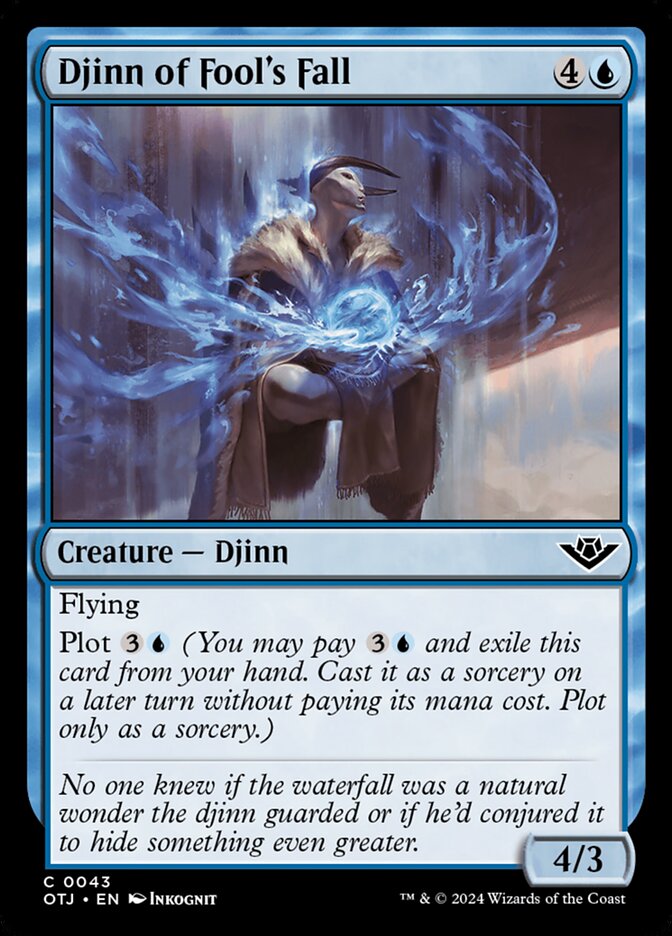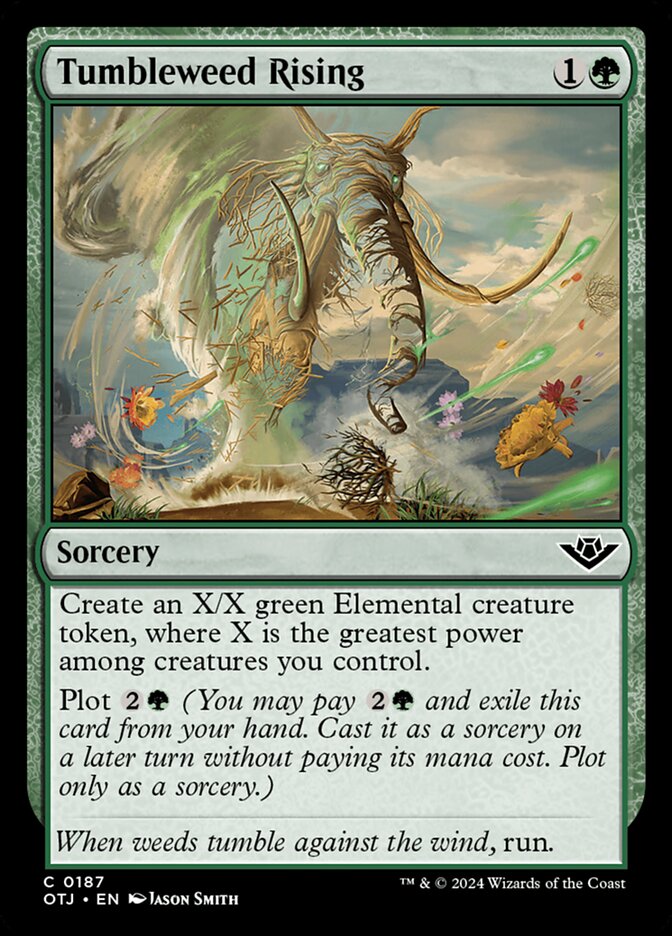The Best Laid Plots in OTJ
04/06/2024
Plot is one of the most interesting mechanics we've gotten recently. It asks a simple question: would you like to cast your spell now, or would you like to spend the mana now but cast it later?
Of course, the default answer is that earlier is better than later - after all, tempo matters a lot. The difference between having a creature on board on-curve vs one turn late is big: a life swing of even 2-3 damage can be extremely relevant, and it can easily be much more than that depending on the situation.
At the same time though, we saw
sagas in NEO perform extremely well overall, and those also had the property of being delayed creatures. Those, however, did give you a lot of value in exchange for being slow. So what does plot offer to make up for the tempo loss?Part 1: Why Should You Plot?
The Card Says Plot
Longhorn Sharpshooter and Aloe Alchemist both have on-plot triggers that are quite good, Sharpshooter especially.
Some other cards directly tell you to plot a card, even if it doesn't have plot itself - mostly rares like
Jace Reawakened, but also one uncommon in Make Your Own LuckFinally, there's the UG signpost legend:
Doc Aurlock, Grizzled Genius. A 2 mana discount is quite hefty, more than enough to justify waiting a turn on most spells in most situations. Some other plot cards also have a natural discount - like Stagecoach SecurityOkay, but what if you don't have any explicit payoff for plotting?
Double or Nothing
There's actually two other archetypes in this set beyond just plot itself that benefit greatly from plotting - namely, UW cares about not casting spells from your hand on your turn, and UR cares about casting multiple spells in one turn.
In UW, plot gives you something to spend your mana on without casting any spells from your hand. You get to plot on one turn and trigger all your
Emergent Hauntings, and you can cast the plotted cards from exile without interfering with those payoffs either.And in UR, plot lets you setup big turns. In fact, some plot cards even explicitly call this out!
Loan Shark and Outlaw Stitcher both want a double spell turn, but are both too expensive to double spell with normally - so plot can be a great way to set this up, either through plotting those cards themselves or plotting other cards to go with them.On top of payoffs like those, some plot cards get better situationally. Take
Dust Animus for example: you'd need to wait until 7 mana if you wanted to get a 4/5 flying lifelink without the plot, but with the plot you can get one on turn 5! Or for another example, Beastbond Outcaster might want to wait until you have a 4 power creature - and you can plot it away early if you have nothing else to do so that you can get it into play freely later.Part 2: Plot With a Plan
With many incentives both to plot and not to plot, I anticipate the mechanic overall will be quite a complex one. It inherently presents quite a lot of options, even with such a simple mechanic. Not only is the decision of whether to plot interesting, the decision of when to cast the plotted card from exile is also sometimes interesting!
The best overall advice I can give is to have a plan. You should always be thinking and planning ahead in Magic, but it's fittingly even more true here!
Plan out your turns: if you're plotting this card now, what do the next couple turns look like? How much more does that let your opponent attack you for? How does that compare to if you just cast it instead?
If you have a plot card in exile, think about what your turn looks like if you cast it now, and what benefits there are for saving it until later. Waiting might be nice for getting more value, but can you afford to wait?
One good comparison to think of in these cases is
Vampire Spawn. Cards like it have proven to be quite good in limited - can you afford to essentially let your opponent get a free Vampire Spawn trigger, because you chose to plot instead of playing immediately to the board?Another comparison is something like
Alley Assailant. In fact, if you're not attacking the comparison is actually quite apt - Assailant lets you play a 3/3 that can't block for a turn or a 2/2 that can block immediately, while many plot cards give the same kind of choice: a worse card now that can block, or a better card next turn that can't block now. As we've seen, creatures that always come into play tapped can be quite awkward! So given the choice, be sure to choose carefully.Part 3: Plotting Groups and Examples
There's 31 cards in the set that have the plot ability. Out of these cards, you can actually form a few distinct categories that all play similarly. So, let's talk about them:
Plot for Value

This is the smallest category, only including
Aloe Alchemist and Longhorn Sharpshooter. Amusingly, these play out very differently, as Sharpshooter almost always wants to be plotted so that it gets a 2-for-1, whereas Alchemist will often provide more damage just by being cast on turn 2 instead of being plotted (notably plot is sorcery speed so the trigger only pushes damage, and is not a trick).Still, even with Sharpshooter, don't be afraid to just cast it for 3 mana! If you have nothing else in hand to do for 3 mana and have plays lined up for the next few turns, it might be better to just play a 3/3 than to completely waste your mana. The 3 mana 3/3 reach mode isn't exciting, but its existence does make the card better!
Mostly Unconditional Creatures

This category includes
Djinn of Fool's Fall, Railway Brawler, Spinewoods Paladin, Slickshot Show-Off, Stingerback Terror, and Stagecoach Security.These all share the trait that they don't vary much in power based on when they're played, and are creatures. Notably, this means that, if you have the choice between plotting or casting, you should probably just cast them! Since as creatures it really matters that they affect the board earlier, and the lack of conditionality means it's probably just better this turn than next turn.
Notably there can be times where these are a bit conditional - Stagecoach Security is one I included as unconditional despite the trigger because I don't think the trigger is worth enough to delay a turn generally; however I can definitely see some spots where it might be worth it to wait. And bombs like Stingerback Terror and Railway Brawler might benefit from getting more immediate value with less risk to removal, but that's a very small effect compared to getting them on board a turn earlier.
You might notice that all of these have a discount on their plot cost! Presumably the designers did this intentionally to encourage plotting these more, as you'll be able to plot one turn sooner than you can cast them. However, I think you should still often just cast a different card instead of plotting these - if you have a 4 drop and a Djinn of Fool's Fall in hand, getting the 4 drop on the battlefield now and the Djinn down next turn is probably better than having both arrive next turn.
But of course, sometimes you don't know if you'll draw a 5th land, and sometimes you want to trigger your UW or UR payoffs. It's a delicate balancing act - how much does not affecting the board this turn matter, and how much do I gain?
Conditional Spells that Affect the Board

This category is the largest by far, and includes over half of all of the plot cards:
Beastbond Outcaster, Blacksnag Buzzard, Cunning Coyote, Demonic Ruckus, Dust Animus, Freestrider Commando, Irascible Wolverine, Loan Shark, Outcaster Trailblazer, Outlaw Stitcher, Rictus Robber, Rise of the Varmints, Sheriff of Safe Passage, Slickshot Lockpicker, Tumbleweed Rising, Unscrupulous Contractor, and Visage Bandit.The conditions on these cards range from pretty easy to satisfy naturally (it isn't hard to have a creature die for Buzzard and Robber), to extremely situational and timing-dependent (like Tumbleweed Rising and Sheriff of Safe Passage). Several of them also care about double spells, so plotting them is akin to being able to bank mana for a big storm turn (Wolverine, Loan Shark, Stitcher, and Lockpicker). Demonic Ruckus is included here because, like creatures, it wants to come down earlier rather than later - but where you put it might matter a lot.
These will include some of the most skill-testing cards in the set, and really ask you to plan ahead. How long should you wait on your Outlaw Stitcher? Should you just cast it immediately for a 2/2? Plot it and double spell next turn for a 4/4? Wait even longer to triple spell for a 6/6? How much is time worth?
Tumbleweed Rising has been especially interesting in my early testing. It's a theoretically powerful card, but has a lot of really interesting sequencing decisions to maximize its power and minimize plowout potential.
Spells that Don't Affect the Board

This last category includes
Brimstone Roundup, Highway Robbery, Pillage the Bog, Pitiless Carnage, Plan the Heist, and Step Between Worlds.As these cards don't affect the board, there's a lot less pressure to cast them early. All except Brimstone Roundup are card draw spells, and Roundup itself mostly wants to be cast in a way that maximizes double spelling - sometimes this means casting it on turn 2, sometimes it means plotting it to setup a double spell on turn 4.
The other card draw spells all ask the question: when do you need more cards?
Highway Robbery is probably the most interest of the bunch (and my favorite design of the whole set!), because of the additional cost. Theoretically, the later the game goes, the better it becomes, as you get more information about which card in hand or land in play is least valuable and therefore best to pitch to it - but you can't wait forever.
So the question becomes: when do you need to improve your hand? You should almost never cast it on turn 2 instead of plotting, as you can't really do anything with immediate cards anyways, but maybe you need to cast it on turn 3 to find a land drop. What if you have a land drop but only a 2 drop to cast on turn 3; do you fire it off then to see if you can improve your hand a bit? Or do you wait until you know whether you want to pitch a land or spell to it?
Questions like these really require you to understand how your deck works and what you can draw, and require to put that together with the direction of the game so far. Is a mediocre turn 3 good enough? Do I need to find removal for the bomb my opponent just played, or can I let them have it for a turn? Do I need to really push for a fast start, or would I rather this Robbery help smooth out my lategame to better be able to grind well?
Conclusion
Plot is complex in its play patterns for how simple the design is - a good sign for a fun format with lots of longevity in gameplay! Hopefully this article can help you in your plot to win!
#FreePalestine | Consider donating to UNWRA or PCRF, supporting protesters locally, and educating yourself.
